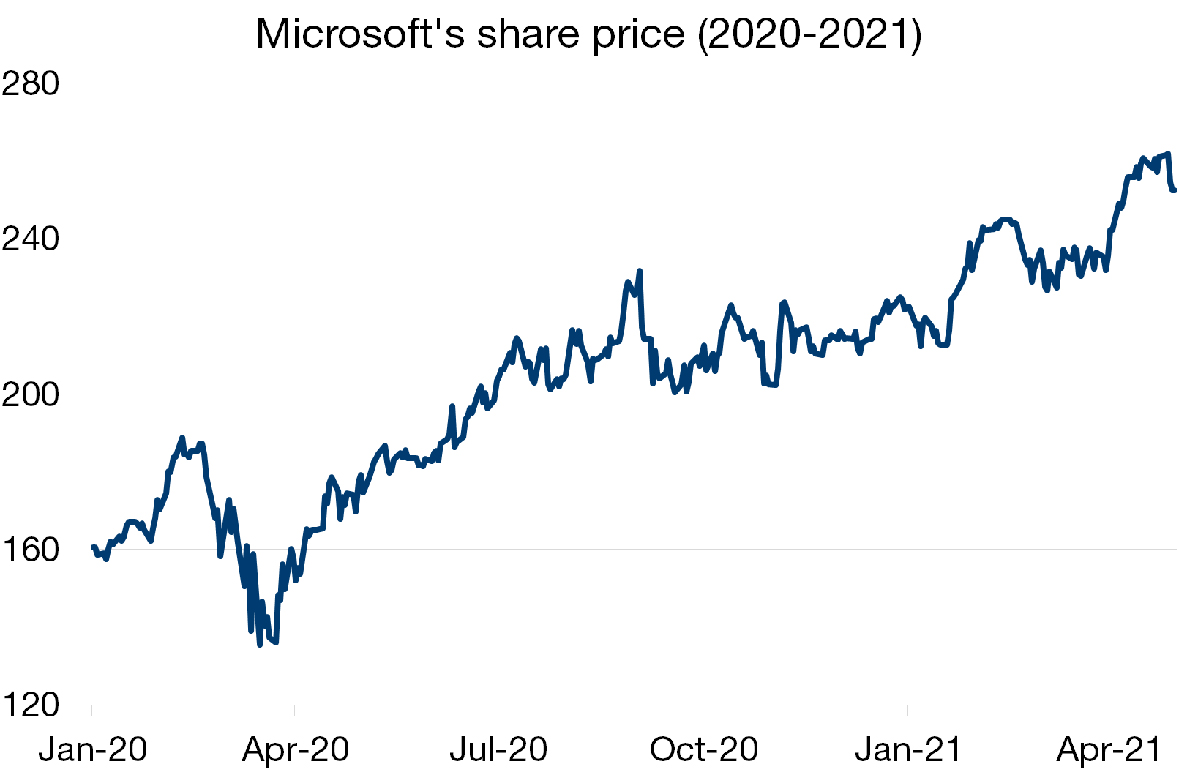03/05/2021
Flash boursier
Key data
| USD/CHF | EUR/CHF | SMI | EURO STOXX 50 | DAX 30 | CAC 40 | FTSE 100 | S&P 500 | NASDAQ | NIKKEI | MSCI Emerging Markets | |
| Latest | 0.91 | 1.10 | 11'022.34 | 3'974.74 | 15'135.91 | 6'269.48 | 6'969.81 | 4'181.17 | 13'962.68 | 28'812.63 | 1'347.61 |
| Trend | |||||||||||
| YTD | 3.19% | 1.49% | 2.98% | 11.88% | 10.33% | 12.93% | 7.88% | 11.32% | 8.34% | 4.99% | 4.36% |
(values from the Friday preceding publication)
“Yes, we do”
Joe Biden was back in action again last week, announcing a new USD 1.8 trillion action plan to help American families. Soon after celebrating his 100th day in office, the new President is making one sucker punch after the next. It’s vaccination at breakneck speed and stimulus packages galore. And the new administration aims to put the government back in control of the economy through the enactment of unprecedented fiscal measures.
The latest package, which will require congressional approval, follows on from the two previous plans for poverty alleviation (USD 1.9 trillion) and infrastructure (USD 2 trillion). This time round, it is targeting low- and middle-income families. Under the new rules, pre-school and public secondary schooling will be free. They also contain childcare support subsidies for families, funding for teacher training, and the creation of a national parental-leave programme.
It is planned that these new measures will be financed by contributions from the wealthiest US corporations and individuals. Taxpayers with an annual income of more than USD 400,000 will see their tax rate increased up to as much as 39.6%. Capital gains tax will be raised to the same rate on wealth over USD 1 million. Under the new rules, tax relief on inheritance tax will be phased out.
Some of the above measures have been described by some as ‘socialist’ – a dirty word in the US. Yet Joe Biden’s ambitions are clear: reduce social disparities, which have never been so wide, and hand a stronger role to the state in this land of red-blooded capitalism, in which only ‘the 1%’ have gained of late.
The Fed will finance these programmes by purchasing Treasury bills, thus sealing a historic alliance between the world’s largest debtor (the US government) and currently its largest creditor (the Fed).
Latest economic stats out of the US corroborate the recovery in GDP, which grew by 6.4% in the first quarter. This was slightly lower than expected, but the uptrend is well and truly under way. Despite a surge in inflation, the Fed does not intend to curb monetary stimulus. It is not shocked by the price upswing, which it qualifies as temporary. Its sole focus for now is restoring the labour market, which shed more than 9 million jobs in 2020.
Corporate earnings releases are flooding into the market. Figures have so far been top notch on average, benefiting from extremely favourable base effects. After all, the first quarter of 2020 was very bad for business. Everything seems to be going well. But we advise investors to remain watchful because expectations are high and there is little room for upsets.
Microsoft
Reporting for the third quarter of the 2021 fiscal year, Microsoft posted strong growth in its three segments (Productivity and Business Process +15%, Intelligent Cloud +23%, More Personal Computing +19%). Total revenues were up 19.1% at USD 41.7bn. Earnings per share rose by 45% to USD 2.03, up from USD 1.40 in the previous-year quarter. The group forecasts sales of between USD 43.6 billion and USD 44.5 billion for the current quarter, which is higher than currently expected by the consensus.
In servers, the growth experienced by the Azure division (business cloud) demonstrates just how successful this move into the cloud computing market has been. The group benefited from the increased use of the Teams video conferencing and instant messaging software (145 million active users), sales of video games (Xbox console) and increased demand for Windows even as computer purchases have mushroomed worldwide.
Fears that growth will cool off after Covid-19 have driven down stock by around 5% relative to its high. At the current market price, Microsoft shares are trading on a price/earnings ratio of 33x. This certainly looks too generous based strictly on the sales metric. But Microsoft can still unlock long-term growth potential and boasts a strong competitive advantage. It is estimated that technology spending as a proportion of GDP will double over the next decade, especially as digitalisation increasingly takes hold. For every additional dollar in revenue generated, the marginal cost to Microsoft becomes lower, thereby boosting profits.


 Flash boursier
Flash boursier
